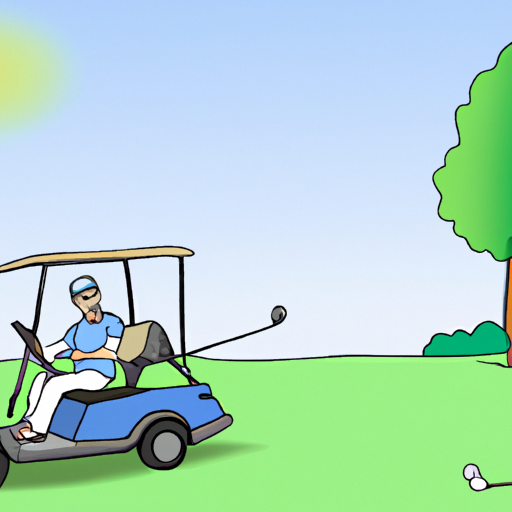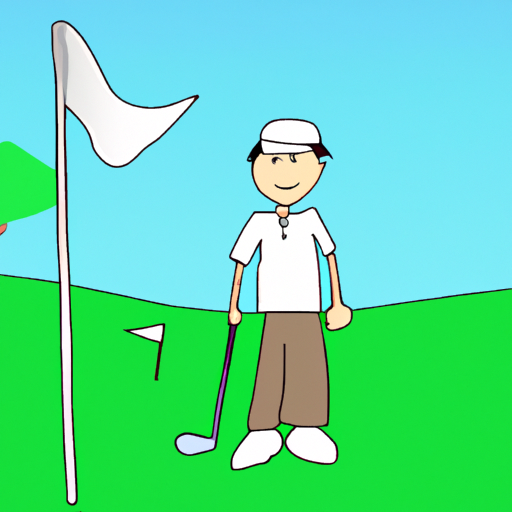- Home
- Golf Swing
- Wrist Hinge With Driver
Mastering the Art of Wrist Hinge with a Driver: A Comprehensive Guide
As a weekend golfer, have you ever wondered what separates the pros from the rest? It's not just about strength or precision, but the subtle nuances of the swing. One such nuance is the wrist hinge with a driver, a technique that can significantly enhance your drive's distance and accuracy.
Imagine standing on the tee, confidently swinging your driver, and watching the ball soar down the fairway. That's the power of a well-executed wrist hinge. It's not just about adding yards to your drive, but also about improving your shot's consistency and control.
Now, think about how mastering this technique could transform your golf game. No more frustration over inconsistent shots or slices. Instead, you'll be hitting longer, straighter drives, impressing your buddies, and perhaps even shaving strokes off your score.
So, are you ready to take the first step towards becoming a better golfer? Let's dive into the art of wrist hinge with a driver, a technique that could be your ticket to golfing success.
 Perfecting the wrist hinge can transform your golf game.
Perfecting the wrist hinge can transform your golf game.The Game-Changing Role of Wrist Hinge in Golf
As a passionate golfer, I've always been intrigued by the subtle nuances that can significantly impact the game. One such aspect is the wrist hinge. It's a seemingly simple movement, but when executed correctly with a driver, it can be a game-changer.
The wrist hinge, in essence, is the flexion and extension of the wrists during the swing. It's a pivotal part of the swing mechanics, influencing the club's speed, direction, and ultimately, the ball's flight. A well-executed wrist hinge can add yards to your drive, improve your shot's accuracy, and even enhance your swing's consistency.
But, the art of wrist hinge is often misunderstood and overlooked. Many golfers, especially beginners, struggle with it. I was one of them.
I remember the days when I would hit inconsistent shots, struggle with slices, and fail to generate enough power. I was frustrated and on the verge of giving up. But then, I discovered the power of wrist hinge.
I spent countless hours practicing it, understanding its nuances, and incorporating it into my swing. Today, I can confidently say that mastering wrist hinge has transformed my game.
So, what exactly is wrist hinge, and why is it so crucial in golf? Let's delve into it.
Understanding Wrist Hinge: Answering the Basics
Wrist hinge in golf refers to the upward and downward movement of your wrists during the swing. It's a pivotal part of the swing mechanics, influencing the club's speed, direction, and ultimately, the ball's flight.
However, there are common misconceptions about wrist hinge. Some golfers believe it's all about the force, while others think it's about the timing. The truth is, it's a delicate balance of both.
The wrist hinge starts during the takeaway when the club is parallel to the ground. From this point, the wrists begin to hinge, and the clubhead starts to elevate.
By the time the club reaches the top of the backswing, the wrists should be fully hinged, with the club shaft parallel to the ground. This position is often referred to as the "L" position because of the angle formed between the left arm (for right-handed golfers) and the club shaft.
However, the wrist hinge doesn't stop at the top of the backswing. During the downswing, the wrists remain hinged until the impact, where they unhinge, releasing the stored energy and propelling the ball forward. This movement is often referred to as the "wrist snap."
Should I Hinge My Wrists with My Driver? The Importance of Wrist Hinge
Now, you might be wondering, "Should I hinge my wrists with my driver?" The answer is a resounding yes.
Wrist hinge can significantly affect your swing with a driver. It can enhance your swing speed, leading to longer drives. Moreover, a well-timed wrist hinge can improve the accuracy of your shots.
The driver is the longest club in the bag, and it requires a full swing to generate maximum power. The wrist hinge plays a crucial role in this full swing. It helps to create a wider swing arc, which translates into more clubhead speed and distance.
Moreover, the wrist hinge also affects the clubface's orientation at impact. A proper wrist hinge ensures that the clubface is square at impact, leading to straighter shots. On the other hand, an improper wrist hinge can cause the clubface to open or close at impact, leading to slices or hooks.
However, it's not just about hinging your wrists; it's about when and how you do it. A premature or late wrist hinge can throw off your swing sequence, leading to inconsistent shots.
So, how do you get it right? Let's find out.
When Should I Start My Wrist Hinge in Golf Swing? Timing Your Wrist Hinge
"When should I start my wrist hinge in golf swing?" is a common question among golfers. The timing of your wrist hinge can make or break your swing. Start too early, and you might lose control; start too late, and you might not generate enough power.
The key is to initiate the wrist hinge during the backswing, just as your hands reach hip height. This timing allows you to maintain control while generating sufficient power for the downswing. However, mastering this timing requires practice and patience.
Here are some drills to help you practice wrist hinge with a driver:
1. The Hinge and Hold Drill: This drill helps you understand the feeling of a proper wrist hinge. Start by taking your regular stance. Hinge your wrists so that the club is vertical, and then swing through. The goal is to maintain the wrist hinge throughout the swing.
2. The Half-Swing Drill: This drill helps you focus on the timing of your wrist hinge. Start by taking a half-swing where you hinge your wrists at the end of the backswing. The goal is to get comfortable with the timing of the wrist hinge.
Remember, these drills are not about hitting perfect shots. They're about understanding and practicing the wrist hinge.
So, don't get discouraged if your shots are not perfect. Focus on the process, not the outcome. And remember, practice makes perfect.
How Do You Hinge Your Wrists in a Golf Swing? The Role of Equipment
How do you hinge your wrists in a golf swing is another question that often comes up. While the technique is crucial, the choice of equipment can also influence your wrist hinge. The right driver can make it easier to execute a proper wrist hinge.
When choosing a driver, consider its weight, length, and flex. A driver that's too heavy or too long can make it difficult to hinge your wrists correctly. On the other hand, a driver with the right flex can enhance your wrist hinge, leading to longer and more accurate drives.
Choosing the right driver is a personal decision. It depends on your physical strength, swing speed, and personal preference. So, don't be afraid to experiment with different drivers until you find the one that suits you best.
Where Should Your Wrist Be on Driver Swing? Advanced Tips and Techniques
So, where should your wrist be on driver swing? At the top of the backswing, your wrists should be fully hinged, with the club shaft parallel to the ground. This position allows you to generate maximum power during the downswing.
However, maintaining this position can be challenging, especially under pressure. Here are some advanced tips and techniques to help you improve your wrist hinge:
1. Stay Relaxed: Tension in your hands and wrists can hinder your wrist hinge. Try to stay relaxed throughout the swing. A good grip is firm but not tight. Remember, the club should be held in the fingers, not the palms.
2. Use Your Body: The power in your swing should come from your body rotation, not just your wrists. Make sure to rotate your body during the swing. The body rotation should initiate the downswing, followed by the unhinging of the wrists.
3. Practice Consistently: Like any golf technique, mastering wrist hinge requires consistent practice. Make it a part of your regular practice routine. Practice your wrist hinge with different clubs, not just the driver. This will help you to develop a consistent wrist hinge across all your shots.
 A golfer demonstrating the perfect wrist hinge during a drive.
A golfer demonstrating the perfect wrist hinge during a drive.The Power of Wrist Hinge
Mastering the wrist hinge with a driver can significantly improve your golf game, leading to longer and more accurate drives. However, it requires understanding, practice, and patience.
So, are you ready to harness the power of wrist hinge in your golf game?
Key Takeaways
1. Wrist hinge is a crucial part of the golf swing, affecting the club's speed and direction.
2. The timing of the wrist hinge is essential. It should be initiated during the backswing, just as your hands reach hip height.
3. The right equipment can make it easier to execute a proper wrist hinge.
4. Regular practice is key to mastering wrist hinge.
Remember, golf is a journey, not a destination. So, keep practicing, keep learning, and most importantly, keep enjoying the game. After all, you're ready for success finally, aren't you?
Now, let's get out there and start practicing our wrist hinge!
Wrist Hinge: Questions and Answers
What is a wrist hinge in golf?
What is a wrist hinge in golf?
A wrist hinge in golf refers to the action of bending your wrists during the backswing. This movement helps to create a lever that can generate a significant amount of power when you swing the club. It's a crucial part of the golf swing that can greatly influence the distance and direction of your shots.
How does wrist hinge affect the driver swing?
How does wrist hinge affect the driver swing?
The wrist hinge plays a significant role in the driver swing. It helps generate power and speed, which are essential for hitting long drives. A proper wrist hinge can also help you maintain control over the clubface, which can improve the accuracy of your shots.
What is the correct way to hinge your wrists with a driver?
What is the correct way to hinge your wrists with a driver?
The correct way to hinge your wrists with a driver is to start the hinge during the takeaway. As you take the club back, your wrists should naturally start to hinge once the club reaches hip height. From there, you continue to hinge your wrists until they reach a 90-degree angle at the top of your backswing.
How can I improve my wrist hinge with a driver?
How can I improve my wrist hinge with a driver?
Improving your wrist hinge with a driver can be achieved through practice and drills. One effective drill involves swinging the club with only your right hand (for right-handed golfers). This can help you feel the correct wrist hinge and release. Another drill involves using a training aid designed to improve wrist hinge.
What are the common mistakes in wrist hinge with a driver?
What are the common mistakes in wrist hinge with a driver?
Common mistakes in wrist hinge with a driver include hinging too early or too late in the backswing, not hinging enough, or over-hinging. These mistakes can lead to a variety of issues, including loss of power, inconsistent ball striking, and off-target shots.
















